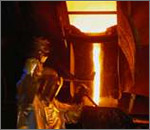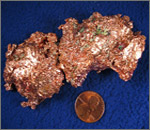Copper (abbreviated Cu) is a relatively soft, pinkish-reddish metalic element. It is technically a "transitional element" rather than a metal, although it is conveniently regarded as a metal in historical contexts. One of the most common carbonates of copper is malachite, which was used in antiquity as a gem stone.

Copper is generally corosion-resistant, but when it is exposed to air, the exposed surface oxidizes, changing the red-pink color, or interacts with ambient sulphur to produce a thin "patina" of blue-green copper-sulphate.
Copper is sometimes found in nuggets, and, like other metals, it turns up occasionally in Paleolithic contexts, but it was not worked as a metal until perhaps 6000-5000 BC. The earliest use was for beads and other ornaments, since copper by itself is too soft for the production of much in the way of useful tools.
Despite this limitation, copper came to be more and more widely used, and archaeologists, especially those working in the Near East, sometimes speak of a Copper Age or "Chalcolithic" (kal-ko-LITH-ic) period from about 5000 to about 3000 BC in that region, or from the end of the Neolithic to the beginning of the Bronze Age. (Others prefer the term "Eneolithic" for this period.) (Obviously not all parts of the world were on the same schedule, or even used copper enough for a term like "Chalcolithic Period" to make any sense.)
As a sign of how important trade in copper became, the Latin word Cuprum, "copper," was apparently originally the name for the island of Cyprus, known for its copper mining, some

what as the English term "china" derives from the name of the country which provided the world with particularly fine ceramics.
Copper ore, although found in many regions, is rarely pure, and it was of little use until it could be removed from its entanglement in other material.Copper melts at about 1,083°C (1,981°F). As ancient pottery workers experimented with the effects of higher temperatures on ceramics they began also to develop methods that could produce a high enough temperature that copper could be melted sufficiently to be separated from the other materials with which it was found. (See below, smelting.)
It was probably early noted that in some cases small admixtures of certain other materials sometimes strengthened copper products or made them the metal easier to work, and various alloys are found, some of which may have been deliberate. Indeed, the distinction between impure copper artifacts and early bronze ones is not always immediately obvious.


